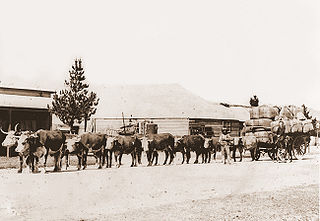 W
WThe Australian Stockman's Hall of Fame is a museum located in Longreach, Queensland, Australia, which pays tribute to pioneers of the Australian outback. The centre is also dedicated to Australian stockmen who have shown bravery and courage.
 W
WVaccinations for cattle involves the process of applying subcutaneous injections of biological microorganisms in a weakened state to help the immune system develop protection by providing active acquirement of immunity to a particular disease. Cattle are bovine livestock and are thus very susceptible to diseases. Vaccinations for cattle are widely used in the livestock industries of the Australian agriculture sector by farmers to prevent harmful and deadly diseases from infecting their livestock, avoiding any economical or biological harm. Farmed livestock industries account for 45% of the gross value of Australian agricultural output, beef cattle being the largest farmed livestock nationally with around 26.2 million head of cattle nationwide. The beef industry within Australia generates a gross value of approximately $8 billion AUD in beef exports and a total gross value of $11.4 billion in farm production (2017–18). Thus, vaccinations play a vital role in protecting, sustaining and growing the beef cattle industry in the Australian agriculture sector.
 W
WA bullocky is an Australian English term for the driver of a bullock team. The American term is bullwhacker. Bullock drivers were also known as teamsters or carriers.
 W
WIn Australia and New Zealand, a cattle station is a large farm, the main activity of which is the rearing of cattle. The owner of a cattle station is called a grazier. The largest cattle station in the world is Anna Creek Station in South Australia, which covers an area of 23,677 square kilometres.
 W
WA drover in Australia is a person, typically an experienced stockman, who moves livestock, usually sheep, cattle, and horses "on the hoof" over long distances. Reasons for droving may include: delivering animals to a new owner's property, taking animals to market, or moving animals during a drought in search of better feed and/or water or in search of a yard to work on the livestock. The drovers who covered very long distances to open up new country were known as "overlanders".
 W
WA jackaroo is a young man working on a sheep or cattle station, to gain practical experience in the skills needed to become an owner, overseer, manager, etc. The word originated in Queensland, Australia in the 19th century and is still in use in Australia and New Zealand in the 21st century. Its origins are unclear, although it is firmly rooted in Australian English, Australian culture and in the traditions of the Australian stockmen.
 W
WMeat & Livestock Australia (M&LA) is an independent company which regulates standards for meat and livestock management in Australian and international markets. Headquartered in North Sydney, Australia; M&LA works closely with the Australian government, and the meat and livestock industries. As a multi-faceted authority, M&LA has numerous roles across the financial, public and research sectors. The M&LA corporate group conducts research and offers marketing services to meat producers, government bodies and market analysts alike. Forums and events are also run by M&LA aim to provide producers with the opportunity to engage with other participants in the supply chain.
 W
WThe National Livestock Identification System (NLIS) is a livestock identification and tracking system used in Australia. It is administered by Integrity Systems Company, which is a wholly owned subsidiary of Meat and Livestock Australia.
 W
WThe Queensland Stock Institute was a government scientific facility in Brisbane, Queensland, Australia, for the research and prevention of disease in agricultural animals relevant to Queensland. Established in 1893, it was the first research institution in Queensland dedicated to the investigation of disease. In 1900, it was renamed the Bacteriological Institute when activities were officially extended to include human pathology. The institute ceased as a facility for livestock disease in 1910 when animal work was transferred to Yeerongpilly. Laboratory work relating to human disease remained at the purpose-built facility under the control of the health department until 1918.
 W
WSquatting is a historical Australian term that referred to someone who occupied a large tract of Crown land in order to graze livestock. Initially often having no legal rights to the land, squatters became recognised by the colonial government as owning the land by being the first European settlers in the area. Eventually, the term "squattocracy", a play on "aristocracy", came into usage to refer to squatters and the social and political power they possessed.
 W
WStock and station agencies are businesses which provide a support service to the agricultural community. Their staff who deal with clients are known as stock and station agents. They advise and represent farmers and graziers in business transactions that involve livestock, wool, fertiliser, rural property and equipment and merchandise on behalf of their clients. The number and importance of these businesses fell in the late 20th century.
 W
WA stock route, also known as travelling stock route (TSR), is an authorised thoroughfare for the walking of domestic livestock such as sheep or cattle from one location to another in Australia. The stock routes across the country are colloquially known as The Long Paddock or Long Paddock.
 W
WA stockwhip is a type of whip made of a long, tapered length of flexible, plaited leather or nylon with a stiff handle and thong able to pivot along the handle easily. Stock whips are used when mustering cattle.